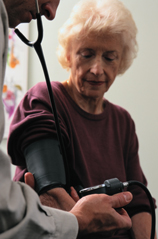Integrate palliative care from early illness onward
The medical community has made progress in palliative care, moving it from the end of the line to a part of a terminal illness' earliest aspect of care.
Jean S. Kutner, FACP, asked for a show of hands about the best timing for palliative care at the start of her session at Internal Medicine 2011. Most audience members indicated they would recommend palliative care early in the course of disease treatment, which seemed to please her.
“I love it,” said Dr. Kutner, professor of medicine in the division of general internal medicine at the University of Colorado School of Medicine in Aurora, Colorado. “It must be 2011 and not 10 years ago.”
A continuum of care

Palliative care should be considered throughout the continuum of care, regardless of the disease stage or other therapies, said Dr. Kutner, who is also the medical editor of the non-profit Foundation for Informed Medical Decision Making. Such care comprises a broad-reaching look at physical symptoms, family dynamics and intellectual, social and spiritual needs.
Another way to think about it, she said, is as a type of care transition, not between settings, but between goals of care. Medicine may focus on curative treatments, but anyone with a serious illness also needs to address physical symptoms, worried families, and possibly anxiety and/or depression.
“We're getting more and more evidence that palliative care needs to be considered further upstream,” Dr. Kutner said. “The question is, when is the right time to engage palliative care and what are the potential benefits of palliative care?”
Palliative care should guide patient-centered decision making and coordinate continuity of care across settings, she said. “At this point, you think it sounds a lot like general medicine, primary care, the patient-centered medical home, [and] geriatrics,” Dr. Kutner said. “It sounds like what we do as internists.”
Evidence for palliative care
A growing body of evidence shows palliative care not only decreases suffering, but improves quality measure outcomes and lowers the costs of end-of-life care.
For patient care, the highest-quality study to date appeared in The New England Journal of Medicine in 2010, Dr. Kutner said. A randomized trial compared early outpatient palliative care integrated with standard oncologic care to oncologic care alone. The study at Massachusetts General Hospital enrolled 150 patients with non-small cell lung cancer.
While the primary outcomes were related to quality of life, such as a mean increase in quality of life, less depression, less likelihood to receive aggressive care and more likelihood to have end-of-life preferences documented, most media reports on the study focused on the longer median survival with palliative care: 11.6 vs. 8.9 months.
“In talking to our community-based providers after this study came out, they suddenly were giving a lot more and earlier referrals, especially among lung cancer patients,” Dr. Kutner said.
A number of studies have also shown that when palliative care is engaged it increases throughput and capacity for acute care admissions, which hospital administrators like, Dr. Kutner said. Newsweek reported in 2006 that the hospitals that were improving care, reducing errors and lowering costs all had active palliative care programs. “So if you need ammunition to bring to your hospital administrator, this is a good one,” she said.
What's more, a 2003 study at Virginia Commonwealth University published in the Journal of Palliative Medicine compared costs before and after patients were referred for palliative care and found that the mean cost per day fell by thousands of dollars after palliative care referrals were made.
Another study published in Archives of Internal Medicine in 2008 looked at direct costs per day for palliative care patients discharged alive or at death. Those discharged alive resulted in an adjusted net savings of $1,696 in direct costs per admission, or $279 per day, and for those patients who died, there was an adjusted net savings of $4,908 direct costs per admission, or $374 per day.
“Again, this is great data to bring to hospital administrators when they say, ‘Why should I support a palliative care service?’” Dr. Kutner said.
Advancing to hospice
As an overarching approach, palliative care may eventually include hospice care, Dr. Kutner said.
Medicare provides a benefit for hospice care in a person with six months or less of life expectancy who has decided to forgo curative or life-lengthening care. Such care is primarily delivered in the home setting, which includes assisted living and nursing facilities. The benefit was conceived for patients with advanced cancer, but this group now makes up only 41% of those who receive hospice care, as other advanced chronic illnesses such as heart disease, dementia and chronic lung disease expand, Dr. Kutner said.
Hospice care has grown to 4,700 programs in the U.S., and in 2007, almost 40% of all deaths in the U.S. occurred under a hospice program. Care is delivered to an older population, 83% over age 65, and overwhelmingly to a white population, she noted.
Several studies have demonstrated the benefits of hospice care, showing fewer unmet needs for pain and emotional support compared to a nursing home, lower spousal mortality at 18 months following the death of the patient, and a general sense of satisfaction with access, coordination of care and communication.
There have been very few studies or cost outcomes in hospice care, however, and they have what Dr. Kutner described as “messy methodologies.” There may be a modest cost saving for those who receive hospice care, with a range among studies of $784 to $2,309 per Medicare beneficiary, she said.
Consider care for the family
Patients naturally want to know their choices for care. They want to know outcomes for alternative interventions, their expected functionality, and whether they will remain productive, Dr. Kutner said. They're not necessarily thinking about life expectancy foremost, she said.
Practical considerations are also on the list for patients, such as how often a clinician will check in on them, how they will pay for hospice care, and how to coordinate care at home.
“The more information we can communicate, the better that conversation tends to go,” Dr. Kutner said.
Family members tend to review hospice experiences favorably if they receive information on symptom management and pain management early in the process, receive emotional support, and have one nurse who is identified as a primary contact, she said. And naturally, they feel the most satisfaction when patients enter hospice not too soon or too late, but just at the right time.
Case study: Dyspnea in end-stage COPD
A 61-year-old woman has end-stage chronic obstructive pulmonary disease (COPD) and increasing dyspnea. Upon physical exam, her blood pressure is 90/55 mm Hg, heart rate 100, respiratory rate 25, with acrocyanosis, skin mottling, jugular venous distension, no audible breath sounds, and oxygen saturation of 84%.
Her medications are oral prednisolone, inhaled anticholinergic and sympathomimetic agents, and oxygen at 4 liters per minute via nasal cannula.
In addition to increasing her oxygen flow, what is the most appropriate next step?
A. Add lorazepam, starting at 0.5 mg p.o. and increase as tolerated.
B. Add olanzapine, starting at 2.5 mg p.o. and increase as tolerated.
C. Add morphine, starting at 5 mg p.o. and increase as tolerated.
D. Add morphine, starting at 5 mg nebulized and increase as tolerated.
Answer and discussion
The correct answer is C. Add morphine, starting at 5 mg p.o. and increase as tolerated.
The American Thoracic Society defines dyspnea as “a subjective breathing discomfort that consists of qualitatively distinct sensations that vary in intensity, not necessarily related to hypercapnia or hypoxia.”
But Dr. Kutner said, “This is what one of my patients described it as: ‘I feel like a fish wrapped in a wet paper towel.’”
In palliative care, first consider treatments that are in line with the patient's care goals, she said. “They want to feel more comfortable, but they also need to consider the risks, benefits and burdens of that intervention,” Dr. Kutner said. “So often we do have to go to symptomatic treatment.”
There is a paucity of randomized, controlled clinical trials on what really works, but oral and systemic opioids have the strongest evidence base, she said. And most of the clinical trials were done for COPD. There is little evidence for nebulized morphine. Benzodiazepines as an adjunct to opioids address the anxiety associated with the shortness of breath.
Oxygen has strong evidence for use in COPD. In cancer patients, it's beneficial only if they're hypoxemic, she said.
Nonpharmacological treatments include neuroelectrical muscle stimulation, chest wall vibration, walking aids and breathing training. There is no evidence for acupuncture, distractive auditory stimuli or relaxation. Fans are frequently used and anecdotally help, although there's no evidence for them, Dr. Kutner said.




